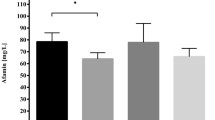Abstract
Retinol binding protein 4 (RBP4) is a novel adipocytesecreted protein that contributes to systemic insulin resistance. Experiments in mice suggest that elevated RBP4 causes insulin resistance. In the present study, we determined serum RBP4 concentration and evaluated its association with insulin resistance in women with polycystic ovarian syndrome (PCOS); 39 PCOS women and 45 healthy control subjects were enrolled in this study. Serum RBP4, fasting plasma glucose (FPG) and fasting serum insulin (FINS) were measured in all subjects. Furthermore, oral glucose tolerance test (OGTT), Botnia clamp (an intravenous glucose tolerance test followed by an euglycemic hyperinsulinemic clamp), and measurements of sex hormones were performed in 13 control subjects and all the PCOS women. The levels of serum RBP4 were elevated in PCOS women compared with the control (11.69 ± 6.72 versus 7.75 ± 5.96 µg/mL, p=0.006). RBP4 levels were positively correlated with WHR (r=0.216, p=0.048), and intravenous glucose tolerance test β cell index (IVGTT-β index) which reflected β cell function (r=0.309, p=0.028), but were inversely correlated with M value during Botnia clamp, which represented insulin sensitivity (r=−0.362, p=0.008). No correlation was found between RBP4 and age, BMI, blood pressure, FPG, FINS, 2-h postprandial glucose, 2-h postprandial insulin, free testosterone, total testosterone, follicle-stimulating hormone (FSH), or luteinizing hormone (LH). In a linear stepwise regression analysis with a model including age, BMI, WHR, free testosterone, IVGTT-β index, and M value as independent variables, only M value showed significant correlation with serum RBP4 levels (r 2=0.105, f=6.640, p=0.012). In conclusion, serum RBP4 levels are significantly increased in PCOS women and associated with insulin resistance, which indicates that RBP4 may be a contributing factor linking adipose tissue with insulin resistance in PCOS.
Similar content being viewed by others
References
Defronzo, R. A. and Ferrannini, E. (1991). Diabetes Care 14, 173–194.
Giamila, F. (2005). J. Allergy Clin. Immunol. 115, 911–915.
Trayhurn, P. (2005). Acta Physiol. Scand. 184, 285–293.
Yang, Q., Timothy, E., Mody, N., et al. (2005). Nature 409, 356–362.
Muoio, D. M. and Newgard, C. B. (2005). Nature 436, 337–338.
Abahusain, M. A., Wright, J., Dickerson, J. W., et al. (1999). Eur. J. Clin. Nutr. 53, 630–635.
Graharn, T. E., Yang, Q., Bluher, M., et al. (2006). N. Engl. J. Med. 354, 2552–2563.
Tarnori, Y., Sakaue, H., and Kasuga, M. (2006). Nat. Med. 12, 30–31.
Tsilchorozidou, T., Overton, C., and Conway, G. S. (2004). Clin. Endocrinol. 60, 1–17.
Ehrmann, D. A. (2000). J. Pediatr. Endocrinol. Metab. 13, 1299–1301.
Fernando, O. and Ricardo, A. (2002). Fertility Sterility 77, 1095–1105.
Salehi, M., Bravo-Vera, R., Sheikh, A., et al. (2004). Metabolism 53, 358–376.
Cibula, D., Skrha, J., Hill, M., et al. (2002). J. Clin. Endocrinol. Metab. 87, 5821–5825.
Devjit, T., Ylva, W., Monica, G., et al. (2003). Diabetes Care 26, 1395–1401.
Kanazawa, M., Yoshiike, N., Osaka, T., et al. (2002). Asia Pac. J. Clin. Nutr. 11(Suppl.), S732-S737.
Sayin, N. C., Fatih, G., Petek, B. K., et al. (2003). J. Reprod. Med. 48, 165–170.
Sepilian, V. and Nagamani, M. (2005). J. Soc. Gynecol. Investig. 12, 129–134.
Fantuzzi, G. (2005). J. Allergy Clin. Immunol. 115, 911–919.
Festa, A., D’Agostino, R. Jr., and Howard, G., et al. (2002). Circulation 102, 42–47.
Chen, J., Wildman, R. P., Hamm, L. L., et al. (2004). Diabetes Care 27, 2960–2965.
Tsutsumi, C., Okung, M., Tannous, L., et al. (1992). J. Biol. Chem. 267, 1805–1810.
Dunaif, A. (1997). Endocr. Rev. 18, 774–800.
Defronzo, R. A., Tobin, J. D., and Andres, R. (1979). Am. J. Physiol. 237, E214-E223.
Soonthornpun, S., Setasuban, W., and Thamprasit, A. (2003). J. Clin. Endocrinol. Metab. 88, 1019–1023.
Author information
Authors and Affiliations
Corresponding author
Rights and permissions
About this article
Cite this article
Weiping, L., Qingfeng, C., Shikun, M. et al. Elevated serum RBP4 is associated with insulin resistance in women with polycystic ovary syndrome. Endocr 30, 283–287 (2006). https://doi.org/10.1007/s12020-006-0006-3
Received:
Revised:
Accepted:
Issue Date:
DOI: https://doi.org/10.1007/s12020-006-0006-3




